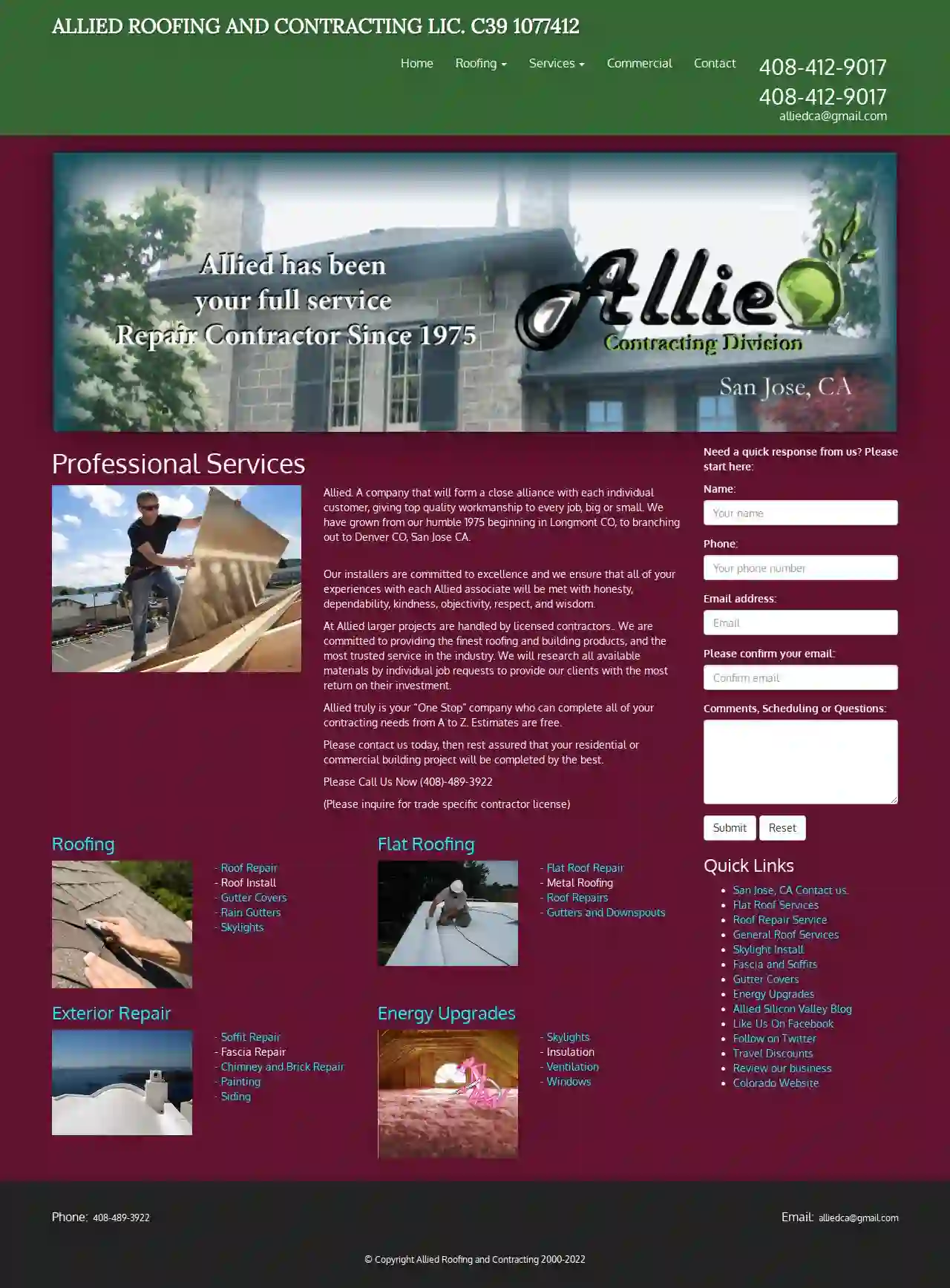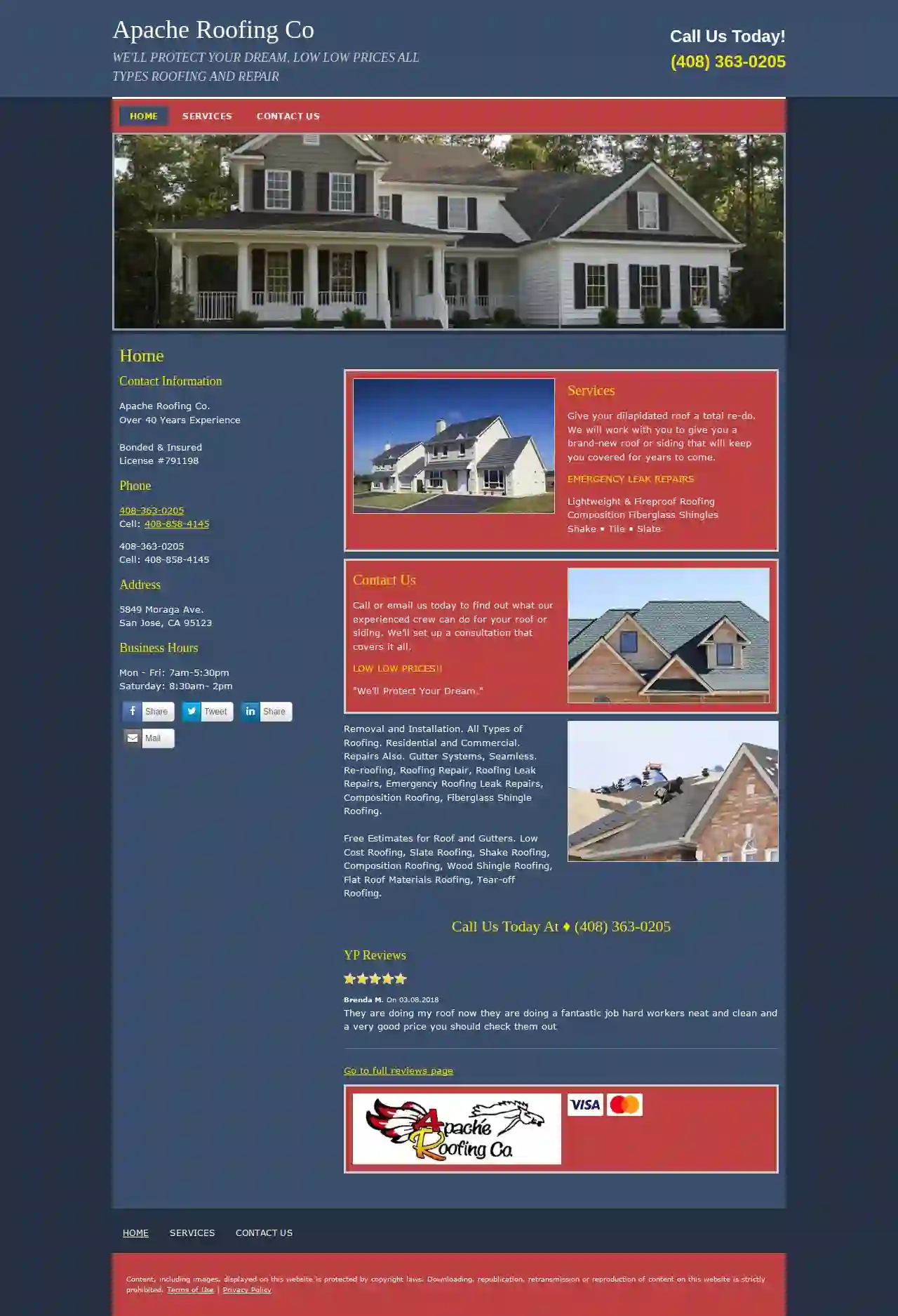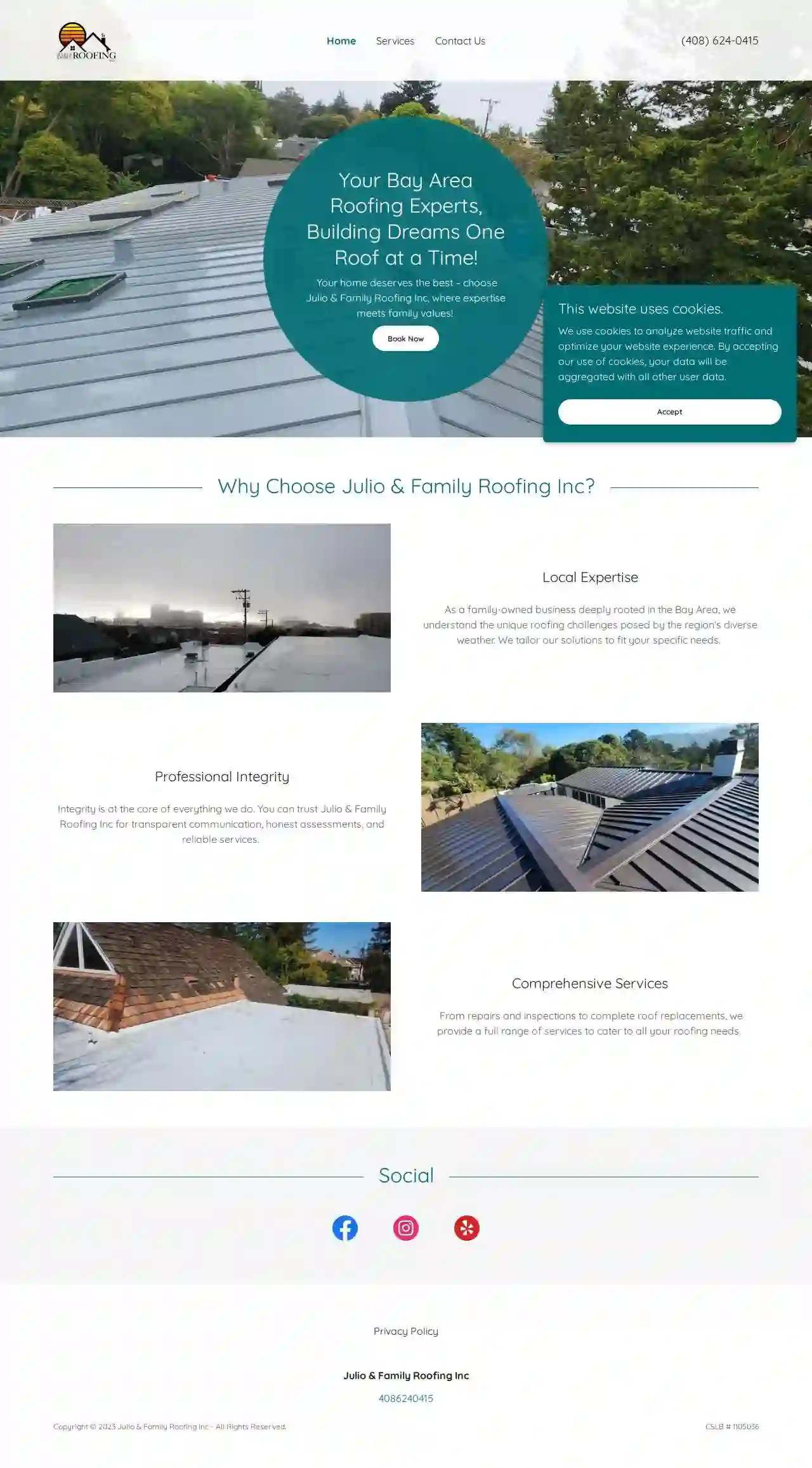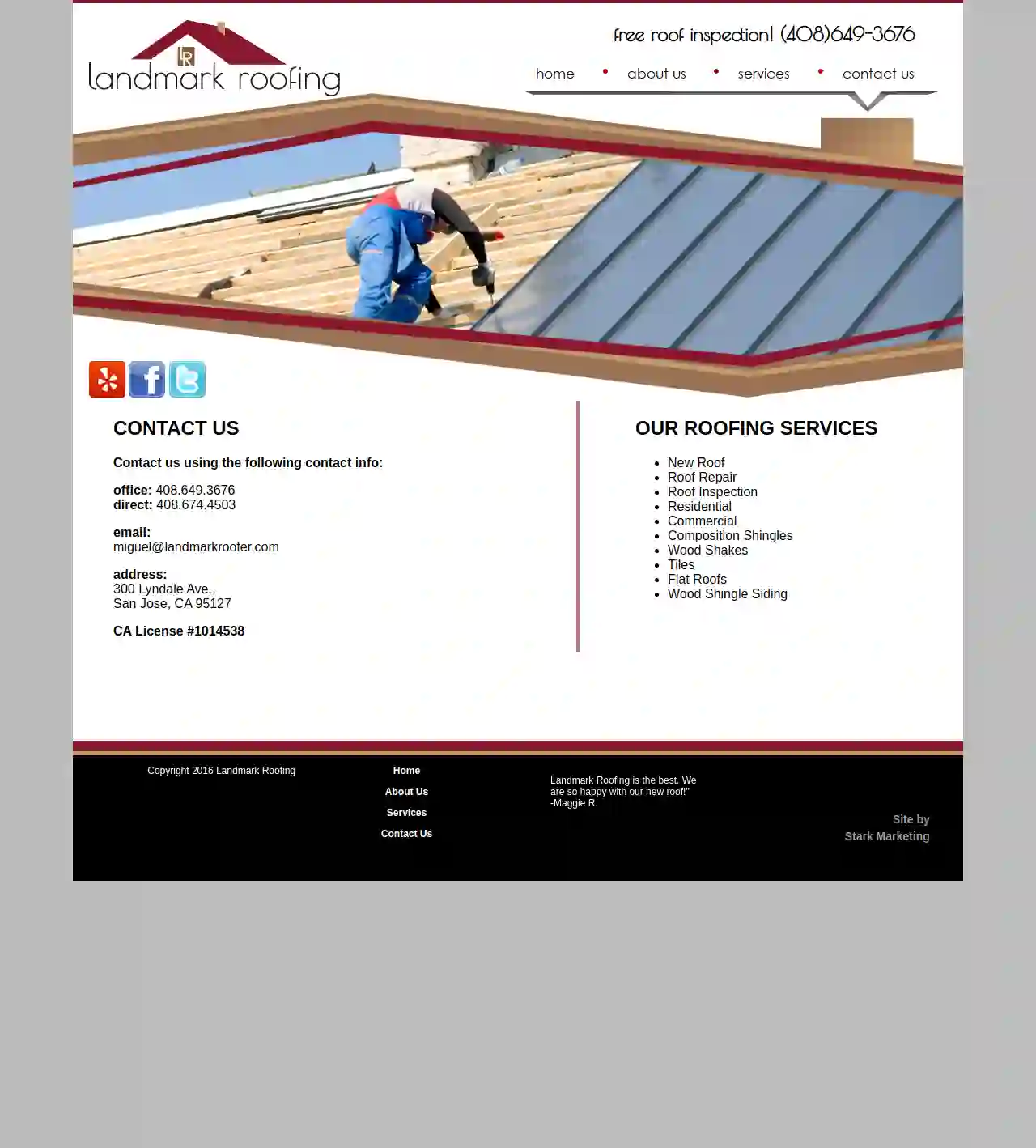Tile Roof Repairs San Jose
Top Fix Tile Roof in San Jose
Get up to 3 Tile Roof Repairs quotes for your project today! Compare profiles, reviews, accreditations, portfolio, etc... and choose the best deal.

Moctezuma Roofing, Inc.
519 reviews351 MacArthur Blvd, San Leandro, CA, 94577, USMy brother and I (Emmanuel and Jacob) have been working in the roofing industry since we were young. We started working with our uncle Refugio and his company Mendoza Roofing when were teens. There we learned the ins and outs of the roofing business. Our uncle made sure we developed a strong work ethic and pride in our work. We started our company in 2012 with the intention to satisfy our customers and to make an impact in our communities. We feel every client we meet becomes a part of our family at Moctezuma Roofing. We treat every roof as it is our own and pride ourselves in our work.
- Services
- Why Us?
- Accreditations
- Our Team
- Gallery
Get Quote
Westshore Roofing, Inc.
4.661 reviews2245 Fortune Dr., Ste A, 2245 Fortune Dr. Ste A, San Jose, 95131, USWestshore Roofing is a highly experienced roofing contractor serving the San Jose and Bay Area for over 25 years. We are known for our high-quality workmanship, excellent materials, and customer-first approach. Our team of professionals specializes in providing accurate and competitive priced estimates for roofing repair, roof replacements, and gutter insulation. We are proud to be considered one of the best roofing contractors in the San Jose and Bay Area, consistently delivering exceptional service and exceeding customer expectations.
- Services
- Why Us?
- Accreditations
- Gallery
Get Quote
Allied Roofing
57 reviews580 Continental Dr., San Jose, 95111, USAllied Roofing and Contracting is a company dedicated to building strong relationships with each customer, providing top-quality workmanship for every project, big or small. Since our humble beginnings in 1975 in Longmont, CO, we've expanded to serve Denver, CO, and San Jose, CA. Our installers are committed to excellence, ensuring every interaction with an Allied associate is marked by honesty, dependability, kindness, objectivity, respect, and wisdom. For larger projects, we work with licensed contractors. We're committed to using the finest roofing and building materials and providing the most trusted service in the industry. We research all available materials for each job to ensure our clients get the best return on their investment. Allied is your one-stop shop for all your contracting needs, from A to Z. Estimates are free. Contact us today and rest assured your residential or commercial building project will be completed by the best.
- Services
- Why Us?
- Accreditations
- Gallery
Get Quote
NC Roofing solution of (San Jose)
512 reviewsSan Jose, USNC Roofing Solution is a premier roofing company serving the San Francisco Bay Area. With years of experience and a commitment to excellence, we provide top-notch roofing services to residential and commercial clients. Our team of experts is dedicated to delivering exceptional results, ensuring your home or business is protected from the elements. We offer a wide range of roofing solutions, including roof rejuvenating, roof repairs, roof replacement, tile roofing, shingle roofing, metal roofing, TPO roofing, modified bitumen roofing, gutter installation, and roof and gutters cleaning. We also offer Roofmaxx, a revolutionary roofing system that provides unparalleled protection and durability. With multiple locations in San Jose, Walnut Creek, San Rafael, and Novato, we are conveniently located to serve your roofing needs. Contact us today to schedule a consultation and experience the NC Roofing Solution difference.
- Services
- Why Us?
- Gallery
Get Quote
Apache Roofing Co
54 reviews5849 Moraga Ave., San Jose, 95123, USApache Roofing Co. is a family-owned and operated business with over 40 years of experience in the roofing industry. We are fully bonded and insured, and our license number is 791198. We offer a wide range of roofing services, including removal and installation, repairs, and gutter systems. We also offer free estimates for roof and gutter services. Our team of experienced professionals is dedicated to providing our customers with high-quality workmanship and exceptional customer service. We are committed to protecting your dream home with our low low prices and all types of roofing solutions.
- Services
- Why Us?
- Testimonials
- Gallery
Get Quote
Julio & Family Roofing Inc
San Jose, USYour Bay Area Roofing Experts! Your home deserves the best – choose Julio & Family Roofing Inc, where expertise meets family values! Book Now Why Choose Julio & Family Roofing Inc? Local Expertise As a family-owned business deeply rooted in the Bay Area, we understand the unique roofing challenges posed by the region's diverse weather. We tailor our solutions to fit your specific needs. Professional Integrity Integrity is at the core of everything we do. You can trust Julio & Family Roofing Inc for transparent communication, honest assessments, and reliable services. Comprehensive Services From repairs and inspections to complete roof replacements, we provide a full range of services to cater to all your roofing needs. We're Here When You Need Us Reliable Roofing Professionals As specialists in residential and commercial roofing services, we are dedicated to providing customer service that is second to none. Whether you have a new construction project or it is time for repairs, we offer the roofing services you need. Individualized Roofing Options From classic shingles to modern metal roofs, our team crafts custom designs that enhance your home's aesthetic appeal while providing exceptional functionality. Your dream roof is within reach! Satisfaction Guaranteed Your satisfaction is our ultimate goal. We prioritize clear communication, transparency, and personalized service, ensuring you’re always in the loop and delighted with the results.
- Services
- Why Us?
- Accreditations
- Gallery
Get Quote
Greenman Roofing
52 reviewsSan Jose, USGreenman Roofing, a leading San Jose Roofing Company, is more than just a roofing contractor – we’re your partner in ensuring the longevity and durability of your home’s roof. Our unique blend of experience, expertise, and local knowledge provides an unbeatable advantage when delivering high-quality roofing solutions. We understand that every roof is unique and every homeowner has different needs. That’s why we tailor our services to your requirements, from repair and maintenance to complete roof replacements. With us, you can rest assured that you’re in the hands of San Jose’s trusted roofing specialists, who are committed to ensuring your roof stands strong against the elements for years to come.
- Services
- Why Us?
- Our Team
- Gallery
Get Quote
Trio Roofers
524 reviewsSan Jose, USRoofing is one of the many aspects of your home that you should never leave to chance. Be aware of the condition of your roof and of any changes after extreme weather. With just a bit of foresight and a little bit of time, you can avoid a major disaster with your roof and save yourself a lot of money. Here at TRIO Roofers, we are concerned with the structural integrity of our customers’ roofs and their home in general. We want to provide them with the roofing services they need to maintain a strong and safe household. Simply, call us at (888) 800-4776 to reach. Our certifications Finance 100% of your Roof! Starts at $99 a month! No credit required! contact us Over 1,283 happy сustomers! Our Customers Agree We are the #1 Roofing Company in the Bay Area. reviews 0 reviews 0 reviews 0 reviews 0 Why choose us? With our many years of experience in this industry, our locally owned and managed company, TRIO Roofers has already built a reputation based on outstanding and affordable customer service for clients in the San Jose, CA. We can take care of any size of roofing jobs, delivering each project using the latest and most effective methods in roof repair or renovation. WATCH OUR GREAT CUSTOMER TESTIMONIAL Play Video Play Video about Trio Roofers commercial testimonial video It is our aim to provide excellent workmanship by using high quality materials, brilliant designs and first-rate repair or installation techniques when doing our projects for homeowners. We take pride in being a reliable contractor as we back all of our works with a satisfaction guarantee. We have a team of skilled roofers that will efficiently deliver any work on time and usually make use of high-tech equipment’s from powerful brands available in the market these days. Our technicians will thoroughly analyze every technical requirements of a project, always considering our customer’s own needs for the roof, whether it’s function, design or budget. Our quality and outstanding professional roofing service has earned us the respect and admiration of our loyal customers. When it comes to roofing jobs, we choose only the best solutions and materials to ensure that the results will be satisfactory.
- Services
- Why Us?
- Gallery
Get Quote
Certified Roofing
57 reviews1659 Branham Lane Suite F-255, San Jose, 95118, USSince 1975, Certified Roofing Has Been a Family Operated and Locally Trusted South Bay Area Roofer Certified Roofing Company offers decades of experience providing residential and commercial roofing systems, roofing installation and roof repair. We serve our customers all over Santa Clara county and the surrounding areas inlcuding Los Gatos, Felton, Morgan Hill, Walnut Creek and more! Look on any street in your neighborhood and compare those roofs with ours... Check out the color match, detailing, ventilation, valleys, flashings, gutters and trim, and find out why we've had happy roof replacement and repair customers going back so many years. Since purchasing a brand, new roof for your home or business means a big commitment as well as spending your hard earned cash, why not do it right the very first time out? No matter how big or small the scope of your roofing project, hiring Certified Roofing headed by David Cameron means you are going to maximize every penny you spend. It also means you'll be working with a local roofing contractor you can absolutely trust! All of Certified Roofing's products and materials come with long-term waranties, and with every new roof we install or replace, we also offer you a top-of-the-line, 10-year labor guarantee so you will always know that if a problem arises, Certified Roofing will be there, standing by you and behind your roof. Remember, a home is often your greatest investment. A quality roof installed properly by an experienced and skilled roof replacement contractor not only protects that investment in your home, it also protects everything that's inside of it! Skilled, Honest Roofing & Construction If you've been looking for a San Jose based roofer you can really count on — an honest contractor you can put up on your roof or inside your home with peace of mind, then read a little more about Certified's history and experience, and then give us a call today at (408) 226-2222! We build custom roofs at Certified because every single one of our customers has a custom project. In other words, no two roofs are exactly the same, and no two customers have the same preferences or needs when it comes to choosing the right roofing system. We really understand this, and we work closely with each client to provide the right roofing materials and high performance home products to suit your specific project, as well as provide you with years of service and protection for your new roof. We also encourage you to educate yourself about the reroofing process by visiting industry sites like The National Roofing Contractor's Association website, or consumer sites like Angie's List and the GAF Blog where you can read articles and get tips on hiring a contractor or choosing your roof products. You should also check out some of our roof installation videos as well as the Certified Roofing Blog to learn more about our company and the work we do for clients just like you all over the San Jose and South Bay area! Ready to start a roofing project right now? Call me, David Cameron, at 408.226.2222 to schedule a FREE INSPECTION or ESTIMATE today! Family Operated & Locally Trusted Certified Roofing can handle any of your roofing or roof repair needs including metal, flat, slate, tile, shake, composition shingle, wood shake, silicone rubber/membrane and much more! We use top quality products and materials from manufactures like GAF and we also offer a full menu of additional home improvement services — from custom rain gutters and skylights to roof repair, radiant barriers, deck coatings and even ventilation. We keep appointments, we answer questions, we provide economical solutions and we always work to maximize the long-term effectiveness of every dollar you spend with us! We recognize and respect that YOU are the person who is spending the money... It's your home, your investment, and we are here to help you! Whether you are a residential homeowner or commercial property owner in the San Jose or Santa Clara county area, we will help you save money on all of your roof installation, repair and home improvement needs. From small leaks to large residential or commercial roof replacements, seamless gutters and more, we do it all and you'll never hear us say any job is too small! We are dedicated to keeping our operating costs LOW, and our quality HIGH. After all, when you choose Certified Roofing, you can depend on the best results, the best prices and the best products for any project you bring us. That's not just something we say; it's our promise to you. From the day we opened our doors, our company was built on a foundation of getting the job done right -- no ifs, ands or buts about it. We proudly continue that tradition today, so many years later. Our Roofing, Repair & Construction Services Need a New Roof? How About a Skylight or Gutters? At Certified Roofing, We Have You Covered! A variety of elements working seamlessly together provides you with a rugged, long-lasting roof. It's a complete system offering beauty and elegance, protection and performance, affordability and lasting value, as well as very little maintenance. A full-service company, we specialize in residential and commercial re-roofing as well as repair. We also offer a large variety of home improvement and home remodeling services including rain gutters and downspouts, waterproofing, skylights and solar tubes, carpentry, handyman work and much more. If you have a home or business with a need, we can probably offer you a top-quality solution! Residential Roofing Commercial Roofing Roof Repairs Skylights Flat Roof Coatings Custom Gutters Radiant Barriers Gutter Covers & LeafGuards Carpentry Insulation Attic Ventilation Deck Coatings Ready to Start a Roofing Project? Request an inspection! It's FREE and there is never any obligation to buy! FREE ESTIMATES! Quality | Craftsmanship | Service From Santa Cruz to Fremont and Santa Clara to Gilroy, we are known for our quality roofing services and installation as well as our remodeling work. We are happy to talk with you about any project you might have in mind. Ask yourself what kind of company sticks around, comes in on budget every time and makes you smile no matter how many challenges arise, and we are confident your answer to that question will end up being Certified Roofing Company. We've earned our great reputation for excellent work over many years and we are very proud of it. So please, just think of us as your one-stop-shop when it comes to home improvement and expert roof replacement and repair. Call me, David Cameron, at 408.226.2222 and let me show you what a quality roofing contractor can do for you and your property today! Get In Touch Today! Have some questions? How about comments? Just want to talk? Connect with us now! Give Us a Call! (408) 226-2222 Visit Us! www.CertifiedRoofing.info Write To Us! 1659 Branham Lane Suite F-255 San Jose, CA 95118
- Services
- Why Us?
- Our Team
- Gallery
Get Quote
Landmark Roofing
53 reviews300 Lyndale Ave., San Jose, 95127, USWelcome to Landmark Roofing. We have over 25 years of experience in the roofing business. As a family owned business, we understand what a roof means to your family. There is nothing more important than the roof that you provide for the security of you and your loved ones. That is why we treat every roof with excessive care and detail, from roof inspections to repairs and especially if a new roof is required. We take great pride in every satisfied customer and give 5 star service in every aspect of each project, from the studs and nails to the shingles or tiles. Give us a call today at (408) 649-3676 to schedule your no-obligation roofing needs
- Services
- Why Us?
- Testimonials
- Gallery
Get Quote
Over 17,196+ Roofing Businesses in our network
Our roofing experts operate in San Jose & surrounding areas!
Roofyng.com has curated and vetted the Best Roofers near San Jose. Find a trustworthy pro today.
Tile Roof Repair FAQs
- Tile Replacement: Removing and replacing broken, cracked, or missing tiles with matching or similar tiles. This involves carefully removing the old mortar, installing new tiles, and repointing with fresh mortar.
- Flashing Repair: Repairing or replacing damaged flashing around chimneys, vents, skylights, and valleys using appropriate materials and techniques to ensure a watertight seal.
- Underlayment Repair: Repairing or replacing damaged or deteriorated underlayment beneath the tiles to prevent leaks.
- Ridge Cap Repair: Repairing or replacing damaged or loose ridge caps to maintain the roof's structural integrity and aesthetic appeal.
- Valley Repair: Repairing or replacing flashing and tiles in the valleys to prevent leaks and ensure proper water drainage.
- Regular Inspections: Inspect your roof twice a year, checking for cracked or missing tiles, loose or damaged flashing, and signs of moss or algae growth.
- Clean Gutters and Downspouts: Ensure proper water drainage to prevent leaks and damage.
- Trim Overhanging Branches: Prevent debris accumulation and potential damage from falling branches.
- Clean the Roof Surface: Periodically clean the roof surface to remove debris, moss, or algae, using a soft brush and a gentle cleaning solution. Avoid pressure washing, which can damage the tiles.
- Repair Promptly: Address any damage or leaks promptly by contacting a qualified tile roof repair contractor.
- Matching Existing Tiles: Using the same type and color for a seamless look is often preferred. However, if your existing tiles are outdated or discontinued, finding a close match may be necessary.
- Tile Type: Clay, concrete, and slate offer different levels of durability, longevity, and cost. Consider your budget and desired aesthetic.
- Style and Profile: Tiles come in various shapes and profiles, such as Spanish, Mission, or Interlocking. Choose a style that complements your home's architectural design.
- Durability and Lifespan: Choose tiles with a long lifespan and good resistance to weather and impact, especially in areas prone to hailstorms or strong winds.
What is the warranty on tile roofs?
Material Warranty: Provided by the tile manufacturer and typically covers defects in the tiles themselves. The duration of the material warranty can vary greatly depending on the type of tile and the manufacturer. Some clay tile manufacturers offer lifetime warranties, while concrete tiles usually have warranties ranging from 20 to 50 years.
Workmanship Warranty: Offered by the roofing contractor and covers their installation workmanship, usually for a shorter period than the material warranty, often 1 to 10 years. It protects against leaks or problems caused by improper installation.
Before hiring a contractor and choosing tile materials, review the terms and conditions of both warranties carefully to understand the coverage and limitations.
What are some common tile roof repair techniques?
What are some tips for maintaining my tile roof?
How do I choose the right tile for my roof repair?
What is the warranty on tile roofs?
Material Warranty: Provided by the tile manufacturer and typically covers defects in the tiles themselves. The duration of the material warranty can vary greatly depending on the type of tile and the manufacturer. Some clay tile manufacturers offer lifetime warranties, while concrete tiles usually have warranties ranging from 20 to 50 years.
Workmanship Warranty: Offered by the roofing contractor and covers their installation workmanship, usually for a shorter period than the material warranty, often 1 to 10 years. It protects against leaks or problems caused by improper installation.
Before hiring a contractor and choosing tile materials, review the terms and conditions of both warranties carefully to understand the coverage and limitations.
What are some common tile roof repair techniques?
- Tile Replacement: Removing and replacing broken, cracked, or missing tiles with matching or similar tiles. This involves carefully removing the old mortar, installing new tiles, and repointing with fresh mortar.
- Flashing Repair: Repairing or replacing damaged flashing around chimneys, vents, skylights, and valleys using appropriate materials and techniques to ensure a watertight seal.
- Underlayment Repair: Repairing or replacing damaged or deteriorated underlayment beneath the tiles to prevent leaks.
- Ridge Cap Repair: Repairing or replacing damaged or loose ridge caps to maintain the roof's structural integrity and aesthetic appeal.
- Valley Repair: Repairing or replacing flashing and tiles in the valleys to prevent leaks and ensure proper water drainage.
What are some tips for maintaining my tile roof?
- Regular Inspections: Inspect your roof twice a year, checking for cracked or missing tiles, loose or damaged flashing, and signs of moss or algae growth.
- Clean Gutters and Downspouts: Ensure proper water drainage to prevent leaks and damage.
- Trim Overhanging Branches: Prevent debris accumulation and potential damage from falling branches.
- Clean the Roof Surface: Periodically clean the roof surface to remove debris, moss, or algae, using a soft brush and a gentle cleaning solution. Avoid pressure washing, which can damage the tiles.
- Repair Promptly: Address any damage or leaks promptly by contacting a qualified tile roof repair contractor.
How do I choose the right tile for my roof repair?
- Matching Existing Tiles: Using the same type and color for a seamless look is often preferred. However, if your existing tiles are outdated or discontinued, finding a close match may be necessary.
- Tile Type: Clay, concrete, and slate offer different levels of durability, longevity, and cost. Consider your budget and desired aesthetic.
- Style and Profile: Tiles come in various shapes and profiles, such as Spanish, Mission, or Interlocking. Choose a style that complements your home's architectural design.
- Durability and Lifespan: Choose tiles with a long lifespan and good resistance to weather and impact, especially in areas prone to hailstorms or strong winds.